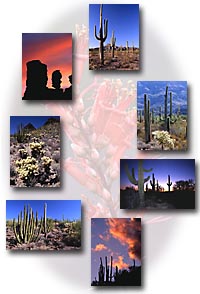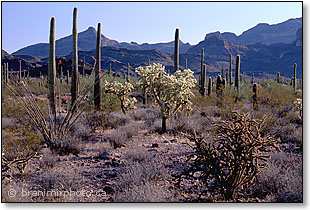
 Organ Pipe
Cactus National Monument, Arizona
Organ Pipe
Cactus National Monument, Arizona
Organ Pipe Cactus National Monument was designated a UNESCO Biosphere Reserve in 1976, for its outstanding variety of desert-type plant and animal life. The park is a must-see destination for outdoor and nature enthusiasts in southwest Arizona.
One reason why the Organ Pipe is so unique is the variety of cacti that call this place home. Twenty six species of cacti can be found in the park, including the saguaro and the park's namesake, organ pipe cactus. Although more abundant in Mexico, the organ pipe is a large cactus found rarely in the USA. The monument contains the majority of its US population.
The Organ Pipe Cactus National Monument is a nature preserve, protecting one of the Earth's major ecosystems in almost ideal wilderness conditions. Two distinctly different Sonoran Desert vegetation zones converge here: the Arizona Upland zone is a lush part of the Sonoran Desert, and includes communities of mixed cacti such as saguaro, organ pipe, prickly pear, teddybear cholla, as well as palo verde trees. This vegetation zone also includes the jojoba / evergreen bush community with jojoba, agave rosewood, and juniper trees. Look for this lush plant community in moist canyons of the Ajo Mountain.
The Lower Colorado zone comes to this area from the west, and is the hottest, driest part of the Sonoran Desert. This vegetation zone is characterized by creosote bush and mixed scrub communities, including brittle-bush, triangle bursage and foothill palo verde plants that can tolerate silty and salty soil. The Central Gulf Coast vegetation zone, usually found in Mexico, is present in small areas of the monument. Atypical plant species such as the elephant tree, senita cactus, and limber bush can be seen from the Puerto Blanco Drive.
You will find organ pipe cactus on south-facing slopes where it can absorb the most of possible sun. Southern exposure also helps the sensitive plants fight off deadly frost during short winter months. Try to notice the hillside distribution of organ pipe relative to saguaro - each prefers different drainage locations. Desert fauna is rich, but less conspicuous. Many animals, including elf owls, kangaroo rats, most snakes, and jackrabbits, roam the desert only during night, to avoid extreme daytime temperatures. Bighorn sheep, most birds, and most lizards prefer daylight hours, although these animals may seek mid-day shade. Coyotes and javelinas are active any time of day that is not too hot.
Organ Pipe Cactus National Monument is located about 220 km (140 mi) east of Tucson; take I-86 east to Why and then I-85 south to the park. Gas, groceries, and limited services are available in Why and Lukeville. Ajo, Arizona, and Sonoya, Mexico, have a wider range of lodging and services. A campground near the visitor centre is open year-round, has drinking water (the only source in the park), restrooms, picnic tables, and fire grills. Expect to see a lot of RVs at the site. There is a backcountry campsite within the monument, and is definitely worth visiting if you do not mind slightly rough conditions. You will need to obtain a backcountry camping permit at the visitor centre.
The best time to visit the monument is between October and April, when temperatures are not extreme. If you are lucky and visit in a year with a rainy spring, you will be rewarded with a profusion of gold poppies, blue lupines, pink owl clover, and other spring flowers. Bright yellow flowers of palo verde are on display in early April. Gentle lavander-white organ pipe cactus flowers open during night hours from May to early July. Other types of cacti bloom during night as well, but many open their flowers during daytime, to gain maximum exposure to the sun. The majority of cacti are in bloom from mid April to early July. The visitor centre can send you a handy sheet including a flowering calendar (-> contact info), as well as an outline of temperature and rainfall information for the park.
See more images of the Organ Pipe Cactus National Monument in the Stock Photography section.
11 January, 2011
Contact us ![]() Privacy policy
Privacy policy ![]() Terms of use
Terms of use
Copyright © Branimir Gjetvaj, all rights reserved
www.branimirphoto.ca
